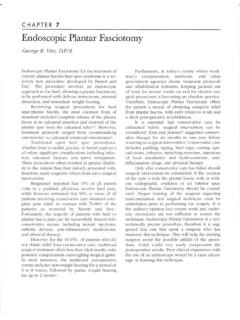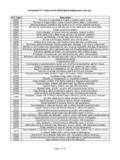Transcription of RHABDOMYOLYSIS ANAESTHESIA TUTORIAL OF THE WEEK 198 - …
1 Sign up to receive ATOTW weekly - email RHABDOMYOLYSIS . ANAESTHESIA TUTORIAL OF THE WEEK 198. 27TH SEPTEMBER 2010. Dr Michelle Barnard, Royal Cornwall Hospital, Truro, UK. Correspondence to SELF-ASSESSMENT QUESTIONS. Please attempt the following questions before reading the TUTORIAL . 1. Which of the following statements is correct? a. RHABDOMYOLYSIS is caused by the breakdown of haemoglobin b. The diagnosis is confirmed by measuring urinary myoglobin levels c. Dark discolouration of the urine results from hypovolaemia d. Status epilepticus is a cause of RHABDOMYOLYSIS 2.
2 Which of the following condition is NOT a recognised cause of rhabdomyolyis? a. Paracetamol toxicity b. Tetanus c. Neuroleptic malignant syndrome d. Dermatomyositis 3. Regarding the management of RHABDOMYOLYSIS , which statements is/are correct? a. After crush injury, treatment should be started in hospital when the patient is fully monitored b. Normal saline is an acceptable crystalloid to use c. There is no requirement for arterial blood gas analysis in an asymptomatic patient d. A urine output of 1ml/kg/hr is adequate INTRODUCTION. RHABDOMYOLYSIS is the breakdown of striated muscle.
3 There are many causes that all ultimately progress to myocyte necrosis and release of intracellular contents into the circulation. This can produce life-threatening complications including hyperkalaemia and acute kidney injury (AKI). EPIDEMIOLOGY. In the ICU setting, the most common causes of RHABDOMYOLYSIS are muscular trauma and vascular RHABDOMYOLYSIS occurs in up to 85% of patients with traumatic injuries. 2 Alcohol has been implicated in the development of RHABDOMYOLYSIS in up to 20% of cases. 3 About a third of all patients with RHABDOMYOLYSIS will develop AKI and it is suggested that 5-25% of all AKI results from Patients with severe injuries that develop RHABDOMYOLYSIS -induced renal failure have a mortality of approximately 20% but is higher if multiple organ dysfunction is ATOTW 198 RHABDOMYOLYSIS 27/09/2010 Page 1 of 5.
4 Sign up to receive ATOTW weekly - email PATHOPHYSIOLOGY. Muscle necrosis is the end-point of RHABDOMYOLYSIS . It results from either direct injury of the sarcolemma (the skeletal muscle cell membrane) or from hypoxia causing ATP depletion and sodium-potassium pump failure. This leads to sodium influx and accumulation of free cytosolic ionized calcium as the cell attempts to restore electrochemical neutrality via the sodium-calcium exchange mechanism. High intracellular calcium activates calcium-dependent proteases and phospholipases causing toxic metabolite production and cell death.
5 Potassium, phosphate, myoglobin, creatine kinase (CK), creatinine and nucleosides (which are metabolized to urate) leak into the circulation. The subsequent inflammation and oedema leads to fluid accumulation in affected muscles and intravascular volume CAUSES. Causes of RHABDOMYOLYSIS can be classified into traumatic and non-traumatic (table 1). The most common cause is direct trauma to the muscle, either from being crushed or from direct pressure , patient lying on the floor for long periods of time and unable to get up. Table 1:Causes of RHABDOMYOLYSIS Traumatic Non-traumatic Ischaemic insult Substance misuse alcohol, cocaine amphetamine, ecstasy Crush injury Drugs statins, fibrates, cocaine, Entrapment antipsychotics, antidepressants (NMS).
6 Prolonged immobilisation Toxins carbon monoxide, heavy metals, Electrical injury snake venom Excessive muscle activity . Infection tetanus, legionella, viral, sepsis marathon running, status syndrome epilepticus, MH. Electrolyte disturbance hypokalaemia, Heat-related heat stroke, hypo/hypernatraemia, hypocalcemia, neuroleptic malignant hypophosphataemia, HONK, DKA, syndrome (NMS), hypothermia hypo/hyperthyroidism (rarely). Muscle enzyme deficiencies Autoimmune dermatomyositis, polymyositis PRESENTATION. Clinical Manifestations The clinical presentation of RHABDOMYOLYSIS varies depending on the aetiology and severity.
7 It may range from an asymptomatic rise in serum CK to hypovolaemic shock with life-threatening arrhythmias. Muscle pains and weakness are common and often associated with general malaise, nausea, tachycardia and confusion. Dark coloured urine may be the first indication of muscle damage. The classic' triad of symptoms includes muscle pains, weakness and dark urine but is seen in less than 10% of patients. 5. Laboratory features Biochemical markers confirm the diagnosis and can be used to predict prognosis. Serum CK levels are the most sensitive indicator of muscle damage, rising within the first twelve hours of injury, peaking at one to three days and declining at three to five A serum CK level over is related to renal failure and is associated with an incidence of AKI of over 50%.
8 5 Levels are directly proportional to the extent of muscle injury. Compartment syndrome compounding the injury may further increase serum CK. 7 Compartment syndrome occurs when increased pressure within a confined cavity within the body (commonly between fascial layers in the limbs) compromised the function of tissues, nerves and blood vessels. ATOTW 198 RHABDOMYOLYSIS 27/09/2010 Page 2 of 5. Sign up to receive ATOTW weekly - email Myoglobin is one of the significant compounds released after muscle disintegration. High circulating levels produce dark-brown discolouration of the urine as myoglobin is filtered by the kidney.
9 Haematuria and myoglobinuria often co-exist, particularly in the context of trauma. The absence of myoglobinuria does not exclude the diagnosis of RHABDOMYOLYSIS so the clinical use is questionable. Many metabolic derangements occur due to the rapid influx of calcium into cells. These include hyperkalaemia, hyperuricaemia, hyperphosphataemia, hypermagnesaemia and initially hypocalcaemia as calcium concentrates in myocytes. Hyperkalaemia is an early feature; electrolytes should be measured as soon as the diagnosis is made. High anion gap metabolic acidosis may develop in severe RHABDOMYOLYSIS due to lactic acid production in ischaemic muscles.
10 COMPLICATIONS. Early Severe hyperkalaemia may lead to arrhythmias and cardiac arrest, especially in association with profound hypovolaemia, hypocalcaemia and acidosis. Early or late Compartment syndrome may develop and is exacerbated by the presence of hypotension. Compartment pressures greater than 30 mmHg are likely to cause significant muscle ischaemia and subsequent secondary RHABDOMYOLYSIS . Hepatic dysfunction occurs in approximately 25 % of individuals. 4. Late Disseminated intravascular coagulation may occur up to seventy-two hours following initial insult.
















